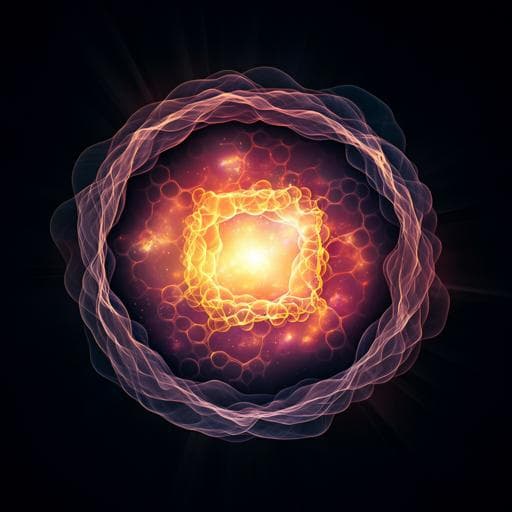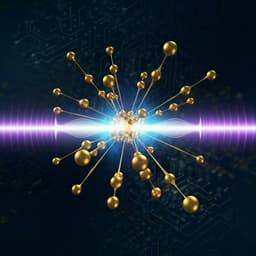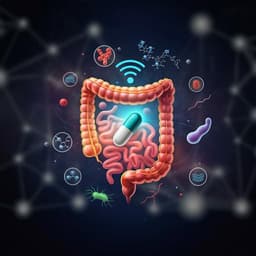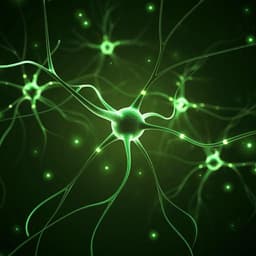
Physics
Real-time observation of a correlation-driven sub 3 fs charge migration in ionised adenine
E. P. Månsson, S. Latini, et al.
This groundbreaking research conducted by Erik P Månsson and team uncovers the fascinating charge migration process in adenine following ionization with an attosecond pulse. Their findings reveal that the delayed second ionization leading to doubly charged adenine could provide a novel method for manipulating molecular reactivity at extraordinarily short timescales.
~3 min • Beginner • English
Introduction
The study investigates whether sudden XUV ionisation of adenine triggers a purely electronic, correlation-driven charge migration before nuclear motion sets in. The context is attosecond science, where electron correlation processes (e.g., shake-up, Auger, ICD) can create superpositions of cationic states leading to ultrafast charge redistribution. Prior work suggested few-femtosecond charge migration in biomolecules using broadband attosecond pulses, but direct time-domain observation of correlation-driven migration initiated by removing an electron from a correlated state remained lacking. The purpose is to track, in real time, many-body electron dynamics on sub-3 fs timescales and to exploit them as a control knob for molecular reactivity before non-adiabatic nuclear effects (typically ≥10 fs) occur. The central hypothesis is that a delayed formation of a stable adenine dication following XUV ionisation and NIR probing is a measurable signature of correlation-driven charge migration (via shake-up) and charge inflation.
Literature Review
The paper situates the work within ultrafast molecular dynamics driven by ionising radiation, highlighting correlated electronic processes like shake-up, Auger, and ICD as key mechanisms. Theoretical predictions have long proposed attosecond charge migration driven by electron correlation in molecules with frozen nuclei. Advances in intense ultrafast XUV and NIR sources have enabled studies of electronic migration and attochemistry, with signatures of few-femtosecond charge dynamics observed in aromatic amino acids via coherent superpositions of cationic eigenstates. However, direct observation of the originally conceived correlation-driven charge migration, initiated by sudden electron removal from a correlated state, was missing. The literature further emphasizes that such purely electronic dynamics survive only until nuclear motion becomes significant (~10 fs), necessitating ultrafast probing to distinguish electronic from non-adiabatic effects. Recent works also show the interplay of multi-electron dynamics and reactivity on longer femtosecond scales and in strong-field regimes, underscoring the need for sub-5 fs resolution to capture intrinsic electron-correlation dynamics.
Methodology
Experiment: An isolated XUV attosecond pump pulse with photon energies 15–35 eV (from high-harmonic generation) ionises adenine in a molecular beam formed by sublimation with helium as buffer gas. A waveform-controlled 64 fs NIR probe pulse (central photon energy 1.77 eV) is combined interferometrically with the XUV to perform pump–probe scans. Ion yields are recorded versus delay using a time-of-flight spectrometer operated in ion mode. The XUV-alone mass spectrum is fragment-dominated (~81% of total yield). Adding the NIR pulse at varying delays enhances fragmentation: small fragment ions (e.g., 27, 38, 53 u) show step-like increases, often at the expense of larger fragments (e.g., 108 u). A delayed appearance near m/z = 67.5 u corresponds to the stable adenine parent dication. Controls with krypton (XUV+NIR double ionisation) verify timing and detection. The dication signal appears only with appropriate XUV spectral content (>7 eV subset removed eliminates it) and shows a delay independent of NIR intensity within 7×10^12–1.4×10^13 W/cm², while its yield scales with NIR intensity.
Theoretical analysis: (1) TDDFT + Ehrenfest dynamics assess nuclear motion significance, indicating nuclei remain effectively frozen over the first ~3 fs; bond elongations begin only after ~3 fs following electron removal from various occupied orbitals. (2) A rate-equation approach estimates shake-up transition times: initial ionic-state distribution from single-orbital ionisation probabilities is combined with Fermi’s Golden Rule for Coulomb-driven shake-up rates. Most transitions occur in hundreds of attoseconds, but a particular excited state (LUMO+6) shows a characteristic shake-up time of ~2.5 fs, compatible with experiment and accessible to subsequent NIR ionisation. (3) Ab initio many-body time-dependent simulations using non-equilibrium Green’s functions with the generalised Kadanoff–Baym ansatz model the XUV photoionisation and delayed NIR absorption with experimental pulse characteristics. Orbital-resolved populations reveal that LUMO+6 is populated over several femtoseconds via shake-up. Spatial electron-density analysis shows rapid out-of-plane charge inflation (increase in density >3 Å from the molecular centre) within the first ~3 fs, with a pattern resembling LUMO+6. Simulations also predict that accessing LUMO+6 requires XUV polarisation perpendicular to the molecular plane. Incorporating the NIR probe shows time-resolved depletion of LUMO+6 that increases for pump–probe delays ~2–4 fs and follows the measured dication yield trend.
Key Findings
- Observation of a delayed formation of the adenine parent dication at m/z ≈ 67.5 u for small positive pump–probe delays, serving as a signature of correlation-driven electronic dynamics initiated by the XUV pulse.
- Dication formation exhibits an exponential rise time τ1 = 2.32 ± 0.45 fs (68% confidence interval). The dication’s decay lifetime is shorter than that of the cationic fragments. Cationic fragment signals display step-like changes followed by slower decays; for cationic pump–probe signals a decay time of 2.43 ± 0.15 fs and a residual decay of ~24.3 fs were extracted.
- The extracted delay for dication formation is insensitive to NIR intensity in the range 7×10^12–1.4×10^13 W/cm², while the dication yield scales with total NIR intensity.
- TDDFT/Ehrenfest simulations show nuclear motion is negligible within ~3 fs; bond elongations commence only after ~3 fs, supporting a purely electronic origin for the early dynamics.
- A Fermi’s golden rule estimate identifies a special shake-up pathway populating LUMO+6 with a characteristic time of ~2.5 fs, matching the experimental delay.
- Many-body NEGF simulations reveal out-of-plane charge inflation within the first ~3 fs and a delay-dependent NIR-induced depletion of LUMO+6 that peaks and rises for 2–4 fs delays, reproducing the measured dication yield trend.
- Orientation dependence: LUMO+6 is accessible for XUV polarisation perpendicular to the molecular plane, suggesting a route for control via molecular alignment/polarisation.
Discussion
The delayed emergence of the parent dication provides a real-time clock for correlation-driven charge migration initiated by sudden XUV ionisation. The experimental 2–3 fs delay aligns with a many-body shake-up mechanism that populates a delocalised excited state (LUMO+6), producing rapid out-of-plane charge redistribution before nuclear motion becomes significant. This correlation-induced charge inflation enhances the probability that a properly delayed NIR pulse can remove the excited electron to form a stable dication, explaining the observed delay dependence and intensity scaling. Together with NEGF simulations that capture shake-up dynamics and reproduce the delay-dependent NIR depletion of LUMO+6, the results demonstrate that electronic correlations can be harnessed on few-femtosecond scales to influence molecular outcomes. The findings validate the hypothesis that purely electronic charge migration can be observed and exploited prior to non-adiabatic relaxation, opening opportunities for controlling molecular reactivity via timing and polarisation of ultrafast fields.
Conclusion
This work provides, to the best of current knowledge, the first direct time-domain evidence of correlation-driven charge migration in a polyatomic molecule, observed as a sub-3 fs delayed formation of an intact adenine dication following XUV ionisation and NIR probing. Theory singles out a special shake-up state (LUMO+6) with a few-femtosecond population time, out-of-plane charge character, and strong NIR coupling, mediating the delayed dication creation. By precisely timing the NIR control pulse, the correlation-driven charge redistribution can be leveraged to prevent dissociative relaxation and stabilise the dication. The study underscores the need for attosecond-to-few-femtosecond resolution to act before non-adiabatic nuclear effects arise. Future directions include coincident electron–ion detection for direct mapping of charge redistribution, advanced many-body methods incorporating nuclear motion, and exploiting molecular orientation and light polarisation to tailor photochemical pathways in complex molecules.
Limitations
- Nuclear dynamics are neglected in the many-body simulations; while calculations and timing arguments indicate nuclei remain effectively frozen within ~3 fs, non-adiabatic effects (e.g., conical intersections) cannot be entirely excluded beyond this window.
- The experiment infers electronic redistribution from ion yields rather than directly imaging charge density, leaving some ambiguity about spatial charge patterns and molecular orientation effects.
- The accessible NIR intensity range is limited; broader intensity and wavelength scans could further test the generality of the mechanism.
- Simulations assume specific pulse characteristics and do not include rotational averaging/orientation distributions explicitly, which may affect the role of polarisation relative to the molecular plane.
Related Publications
Explore these studies to deepen your understanding of the subject.







